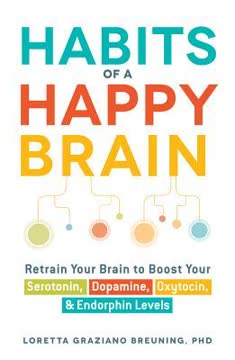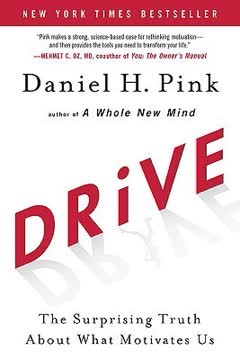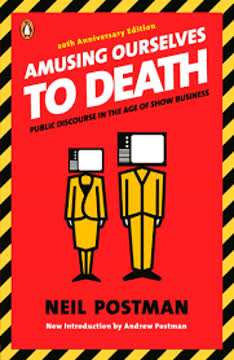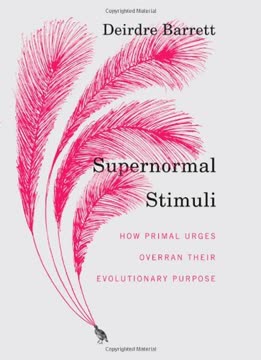Key Takeaways
1. Supernormal Stimuli: Exaggerated Instinct Triggers
The essence of the supernormal stimulus is that the exaggerated imitation can exert a stronger pull than the real thing.
Instincts gone awry. Humans, like other animals, possess primal instincts evolved for survival in ancient environments. However, our modern world, vastly different from the African savannahs of our ancestors, presents artificial stimuli that are exaggerated versions of natural cues. These "supernormal stimuli" can trigger our instincts more powerfully than the real objects they evolved for, leading to behaviors that are no longer adaptive or beneficial.
Evolutionary mismatch. Our instincts were designed to call attention to rare necessities like calorie-dense foods, fertile mates, or potential threats. Today, technology allows us to manufacture useless attention-grabbers that exploit these instincts. This mismatch between our ancient biology and our rapid technological and societal change plays a significant role in many modern problems, from health crises to social dysfunction.
Beyond basic needs. While the concept originated in animal behavior, it applies broadly to human folly. Supernormal stimuli explain why we might prefer candy over fruit, stare at idealized images over real people, or become engrossed in fictional dramas over our own lives. Recognizing how these exaggerated cues operate is the first step toward understanding and addressing the problems they create.
2. Animal Research Revealed Instincts Can Be Hijacked
The most interesting of Tinbergen’s discoveries was that dummies could surpass the power of any natural stimuli.
Pioneering ethology. Nobel laureate Niko Tinbergen's research on animal behavior revealed that instincts are often triggered by specific, simple cues. By creating artificial models that exaggerated these cues, he found he could elicit stronger responses than the natural objects themselves. This led to his concept of supernormal stimuli.
Classic experiments:
- Graylag geese preferred to roll a giant, brightly colored dummy egg over their own.
- Stickleback fish attacked crude red shapes more violently than realistic models without red undersides.
- Songbirds preferred to feed fake baby bird beaks that were wider and redder than their own chicks'.
- Male butterflies ignored live females to mount cardboard cylinders with exaggerated markings and movements.
Simple triggers. These experiments demonstrated that animal instincts are coded for a few key traits, and amplifying these traits can easily fool the animal's innate responses. This mechanistic view of behavior, focusing on observable actions and triggers rather than internal states, was revolutionary and laid the groundwork for understanding how instincts could be exploited.
3. Sex and Beauty: Amplifying Primal Attraction
To encounter erotica designed to appeal to the other sex is to gaze into the psychological abyss that separates the sexes.
Exploiting attraction. Sex is a prime target for supernormal stimuli. Pornography, advertising models, plastic surgery, and cosmetics all amplify natural signals of attractiveness and fertility. These exaggerated cues often target specific gender instincts, highlighting the differing evolutionary pressures on men and women regarding mate selection.
Visual vs. relational. While men's sexual instincts are often triggered by visual cues (leading to the appeal of pornography and idealized images), women's desires, as seen in romance novels and celebrity crushes, often focus on personality, status, and relational security. Media creates supernormal versions of ideal partners, from physically perfect models to emotionally available fictional heroes.
Unrealistic ideals. Modern media, enhanced by technology like Photoshop, presents highly curated and often digitally altered images of beauty. This creates a pool of potential comparisons that is vastly different from our ancestral environment, leading to widespread self-esteem issues as people compare themselves to unattainable, artificially produced ideals.
4. Cuteness: Hijacking the Nurturing Instinct
Cuteness signals often go far astray of their intended targets.
Infantile triggers. Cuteness, characterized by features like large heads, big eyes, small noses, and clumsy movements, is an evolutionary mechanism designed to trigger nurturing instincts in adults. This is crucial for the survival of helpless young across species. Scientific studies confirm that cute infants receive more attention and care.
Beyond our species. Humans find baby animals cute and often adopt them, sometimes with negative consequences when the animals grow up ill-equipped for the wild. Animals can also respond to cuteness cues from other species, as seen in documented cases of leopards or monkeys adopting human children, demonstrating the powerful, cross-species nature of this instinct.
Marketing and neoteny. Cuteness is a powerful marketing tool, exploited in toys, cartoons (like Mickey Mouse's evolving features or Japanese kawaii culture), and advertising mascots. This taps into our instinct to nurture, even towards inanimate objects. Neoteny, the retention of childlike features into adulthood (seen in domesticated animals and humans compared to other primates), contributes to this appeal and may be linked to behavioral traits like playfulness and curiosity.
5. Food: Our Ancient Cravings Exploited
Fast-food and self-interested advertisers did not create our craving for fats, sugar, and salt, though they exploit them.
Hunter-gatherer palate. Our ancestors evolved strong cravings for fats, sugar, and salt because these were rare and essential for survival on the savannah. Today, these substances are cheap, abundant, and concentrated in highly refined "junk food," creating supernormal food stimuli that our bodies are hardwired to crave excessively.
Agriculture's impact. The shift to agriculture 10,000 years ago, focusing on starchy grains, was the first step away from a diverse, nutrient-rich diet. Modern food refining processes further strip nutrients while concentrating addictive components. Fast food chains have perfected this, creating products with optimal ratios of refined carbs, saturated fat, and salt that are difficult to resist.
Health crisis. This constant bombardment with supernormal food stimuli has led to an obesity epidemic and related diseases like type 2 diabetes, heart disease, and certain cancers. Our bodies' natural hunger and satiety signals are overwhelmed, and refined foods can trigger brain pathways similar to those involved in drug addiction, making it difficult to eat moderately or choose healthy options.
6. Territory and Threat: Instincts Fueling Conflict
Man biologically considered…is simply the most formidable of all the beasts of prey, and, indeed, the only one that preys systematically on his own species.
Nomadic origins. Humans are naturally nomadic, evolved to roam in small groups with overlapping home ranges, not defend fixed territories or accumulate vast personal property. Agriculture tied us to land, and increasing population density led to sharper boundaries and a heightened sense of territoriality and ownership, often defended violently.
Supernormal threats. Our instincts for sensing threats are honed for the immediate, visible dangers of the savannah (predators, rival groups). In the modern world, media and political leaders create supernormal versions of threats – often distant, abstract, or exaggerated – that trigger disproportionate fear and aggression, diverting attention from more likely, less dramatic dangers like traffic accidents or chronic disease.
Pseudospecies and war. Psychoanalyst Erik Erikson's concept of "pseudospecies" describes how human groups (tribes, nations, religions) create a sense of unique, superior identity while demonizing others. This allows us to apply our instincts for within-species cooperation only to our own group and unleash extreme violence against others, often fueled by propaganda that portrays the enemy as less than human.
7. Media and Sports: Vicarious Living Replaces Reality
Television is the first truly democratic culture—the first culture available to everybody and entirely governed by what the people want.
Orienting response hijacked. Television and other media exploit our instinctual "orienting response" – the reflex to pay attention to sudden movement or sound. Rapid cuts, zooms, and noises constantly trigger this reflex, keeping us glued to the screen but leading to passive, low-attention states that drain energy and hinder cognitive function.
Supernormal social and adventure. Media provides supernormal stimuli for our social and adventure instincts. Sitcoms offer effortless "friendship," romance novels provide idealized relationships, and action/disaster films deliver exaggerated thrills and threats (giant monsters, swarming insects, meteors) that tap into ancient fears more effectively than real-world risks.
Spectator vs. participant. Sports, originally a form of exercise and skill practice, have largely become spectator events. Watching professional athletes or even children's organized sports replaces personal physical activity with vicarious experience. This channels our instinct for movement and competition into passive consumption, contributing to sedentary lifestyles and related health problems.
8. Intellectual Pursuits: Brains Seeking Supernormal Puzzles
Our brains did not evolve to do calculus or physics or to compose sonnets or fugues.
Neotenous curiosity. Humans retain childlike curiosity and playfulness into adulthood more than other animals, a trait linked to our prolonged brain development (neoteny). This intellectual drive leads us to seek novel, challenging problems, even those without immediate practical application.
Games and puzzles. Puzzles (mazes, crosswords, Sudoku) and games (Go, chess, poker, video games) are clear examples of supernormal stimuli for our intellect. They provide abstract challenges that are often more intriguing than real-world problems, absorbing vast amounts of human energy and time.
Careers and creativity. Many modern careers, from abstract science (like particle physics) to finance ("money is just how you keep score"), are driven by the intellectual puzzle they present. Art, too, is fueled by curiosity and play, creating supernormal stimuli for aesthetic ideals. This redirection of intellectual energy, while sometimes leading to beneficial discoveries, often prioritizes interesting problems over practical ones.
9. Our Giant Brains Can Override Instincts
Humans have one stupendous advantage over other animals—a giant brain capable of overriding simpler instincts when they lead us astray.
Conscious override. Unlike animals, whose responses to supernormal stimuli are largely automatic, humans possess a large prefrontal neocortex capable of conscious thought, complex reasoning, and overriding reflexive instincts. This is our key advantage in navigating a world filled with exaggerated cues.
Making the ordinary strange. Psychologist William James advocated training ourselves to "make the ordinary seem strange" – to question why we behave instinctively and consider alternative actions. This perspective, which came naturally to Tinbergen, is crucial for recognizing when our instincts are being exploited by supernormal stimuli.
Willpower and habit change. Overriding instincts requires willpower and conscious effort, especially when changing established habits. Techniques like cognitive behavioral therapy and hypnosis can help by making us aware of triggers, challenging faulty reasoning, and reinforcing healthier choices until new, more adaptive habits become automatic.
10. Escaping the Plaster Egg: Reclaiming Our Choices
We are the one animal that can notice, “Hey, I’m sitting on a polka-dotted plaster egg” and climb off.
Recognize the lure. The first step to mitigating the negative effects of supernormal stimuli is simply recognizing them for what they are – exaggerated, artificial cues designed to trigger outdated instincts. This awareness allows us to engage our conscious intellect rather than reacting automatically.
Individual action. We can make conscious choices to reduce exposure to supernormal stimuli:
- Eat whole, unprocessed foods instead of refined junk food.
- Engage in real social interactions and physical activities instead of passive media consumption.
- Question media narratives and political propaganda that demonize others.
- Choose intellectual pursuits that have practical benefits or enhance well-being.
Societal change. Collective action is also necessary to reshape our environment:
- Implement policies to regulate unhealthy food advertising and ingredients.
- Design cities that encourage walking and physical activity.
- Promote media literacy and critical thinking about information sources.
- Foster understanding and empathy across different human groups.
Shaping pleasure. Our pleasure system is flexible and can be trained to find satisfaction in healthier, more adaptive behaviors. By consciously choosing to prioritize real needs and genuine connections over the fleeting, exaggerated rewards of supernormal stimuli, we can lead more fulfilling lives and build a more sustainable society.
Last updated:
FAQ
1. What is "Supernormal Stimuli: How Primal Urges Overran Their Evolutionary Purpose" by Deirdre Barrett about?
- Core Concept: The book explores the idea of "supernormal stimuli," exaggerated artificial triggers that hijack our primal instincts, leading us to act in ways that are maladaptive in the modern world.
- Evolutionary Mismatch: Barrett argues that many of our current problems—obesity, addiction, aggression, and media overconsumption—stem from instincts evolved for a very different environment than today's.
- Interdisciplinary Approach: The book draws on evolutionary psychology, ethology, neuroscience, and cultural analysis to explain how and why our instincts are manipulated.
- Practical Implications: Barrett discusses how recognizing and understanding supernormal stimuli can help us override these instincts and make better choices in modern life.
2. Why should I read "Supernormal Stimuli" by Deirdre Barrett?
- Understand Modern Problems: The book provides a compelling framework for understanding why so many modern issues—like overeating, addiction, and media obsession—are so pervasive and difficult to solve.
- Actionable Insights: Barrett offers practical advice on how to recognize and resist supernormal stimuli, empowering readers to make healthier, more conscious decisions.
- Engaging Storytelling: The book is rich with fascinating animal studies, historical anecdotes, and cultural observations that make complex scientific ideas accessible and memorable.
- Broader Perspective: It encourages readers to "make the ordinary seem strange," fostering critical thinking about everyday behaviors and societal norms.
3. What are the key takeaways from "Supernormal Stimuli" by Deirdre Barrett?
- Supernormal Stimuli Defined: Artificial exaggerations of natural triggers can override our evolved instincts, often leading to maladaptive behaviors.
- Modern Mismatch: Our brains and bodies are adapted for a hunter-gatherer environment, not the abundance and complexity of modern society.
- Examples Across Life: Supernormal stimuli affect everything from food (junk food), sex (pornography), cuteness (toys, pets), aggression (war, media), to intellectual pursuits (puzzles, games).
- Override Instincts: Humans have the unique capacity to recognize when instincts are being hijacked and to consciously override them using our advanced brains.
4. How does Deirdre Barrett define "supernormal stimuli" in "Supernormal Stimuli"?
- Origin of the Term: Coined by Nobel laureate Niko Tinbergen, "supernormal stimuli" refers to exaggerated artificial cues that elicit stronger instinctive responses than the natural objects they mimic.
- Animal Examples: Birds preferring to sit on oversized, brightly colored eggs rather than their own; male fish attacking redder dummies over real rivals.
- Human Examples: Candy sweeter than fruit, pornography more stimulating than real partners, and media more engaging than real-life social interactions.
- Key Mechanism: These stimuli exploit the fact that instincts are coded for a few traits, and amplifying those traits can easily fool both animals and humans.
5. What are some real-world examples of supernormal stimuli in human life, according to Barrett?
- Food: Highly processed foods with excessive sugar, fat, and salt are more appealing than natural foods, leading to overeating and obesity.
- Sex and Romance: Pornography, advertising, and digitally altered images create unattainable standards and can be more stimulating than real relationships.
- Cuteness: Toys, cartoons, and pets are designed with exaggerated infantile features to trigger nurturing instincts.
- Media and Entertainment: Television, video games, and social media provide hyper-stimulating versions of social and adventure experiences, often replacing real-life engagement.
6. How does "Supernormal Stimuli" by Deirdre Barrett explain the obesity epidemic?
- Evolutionary Roots: Our ancestors evolved to crave rare, calorie-dense foods, but in today's world, these foods are abundant and artificially enhanced.
- Refined Foods: Modern food processing creates supernormal versions of natural foods, making them more addictive and less nutritious.
- Habit Formation: Repeated exposure to junk food changes brain chemistry and eating habits, making it harder to resist.
- Societal Factors: The food industry exploits these instincts, and government policies often reinforce unhealthy choices through subsidies and marketing.
7. In what ways does "Supernormal Stimuli" discuss the impact of media and technology on human behavior?
- Hijacking Attention: Television and digital media use rapid cuts, bright colors, and novel stimuli to trigger our orienting response, making them hard to ignore.
- Passive Consumption: Excessive screen time leads to reduced physical activity, lower mood, and impaired cognitive development, especially in children.
- Vicarious Socialization: Media provides artificial social experiences that can replace real interactions, leading to loneliness and social skill deficits.
- Addictive Qualities: The structure of media content (cliffhangers, endless scrolling) is designed to keep us engaged far beyond what is beneficial.
8. How does Deirdre Barrett use animal research and evolutionary psychology to support her arguments in "Supernormal Stimuli"?
- Tinbergen’s Experiments: The book details Niko Tinbergen’s classic studies with birds, fish, and insects to illustrate how instincts can be fooled by artificial exaggerations.
- Comparative Analysis: Barrett draws parallels between animal behaviors and human responses to modern supernormal stimuli.
- Evolutionary Mismatch: She explains that many of our instincts are outdated, having evolved for environments very different from today’s world.
- Ethology and Psychology: The book integrates findings from animal ethology, sociobiology, and evolutionary psychology to build a comprehensive framework.
9. What solutions or advice does "Supernormal Stimuli" by Deirdre Barrett offer for overcoming the negative effects of supernormal stimuli?
- Conscious Override: Barrett emphasizes the importance of using our advanced brains to recognize when instincts are being hijacked and to consciously override them.
- Habit Change: She discusses strategies like cognitive behavioral therapy and hypnosis to help individuals change unhealthy habits.
- Environmental Engineering: The book advocates for societal changes—like healthier food policies, urban design for more physical activity, and media literacy—to reduce exposure to supernormal stimuli.
- Critical Awareness: Encourages readers to "make the ordinary seem strange" and question everyday behaviors and cultural norms.
10. How does "Supernormal Stimuli" by Deirdre Barrett address aggression, war, and group conflict?
- Instincts for Defense: Barrett explains that instincts for territoriality and defense, once adaptive, are now amplified in crowded, complex societies.
- Pseudospecies Concept: She discusses how humans create "pseudospecies"—in-groups defined by nationality, religion, or ideology—which can lead to dehumanization and conflict.
- Media and Propaganda: Modern media and political leaders exploit these instincts, using supernormal stimuli to whip up fear and aggression.
- Potential for Peace: Barrett suggests that recognizing these patterns and using technology for empathy and understanding can help override destructive instincts.
11. What role does "cuteness" play in "Supernormal Stimuli" by Deirdre Barrett, and how is it exploited?
- Nurturing Instincts: Cuteness is defined as a set of infantile features that trigger nurturing responses in adults, an adaptation for offspring survival.
- Exaggerated Cuteness: Toys, pets, and media characters are designed with supernormal cute features (big eyes, round faces) to hijack these instincts.
- Cultural Phenomena: The book explores how cultures like Japan have developed entire industries around "kawaii" (cuteness), sometimes diverting resources from real human needs.
- Potential Downsides: While generally less harmful than other supernormal stimuli, the overemphasis on cuteness can lead to misplaced nurturing and consumerism.
12. What are the best quotes from "Supernormal Stimuli" by Deirdre Barrett and what do they mean?
- "Our modern skulls house a stone age mind." — This quote, borrowed from evolutionary psychologists, encapsulates the book’s central thesis that our instincts are mismatched to the modern world.
- "The exaggerated imitation can exert a stronger pull than the real thing." — Highlights how supernormal stimuli can override natural preferences, leading to maladaptive behaviors.
- "The key to most of our modern crises lies in 'making the ordinary seem strange.'" — Encourages readers to critically examine everyday behaviors and question their origins and consequences.
- "We are the one animal that can notice, 'Hey, I’m sitting on a polka-dotted plaster egg' and climb off." — A metaphor for our unique human ability to recognize and escape the traps set by supernormal stimuli.
Review Summary
Supernormal Stimuli receives mixed reviews, with an average rating of 3.68/5. Some praise its exploration of how exaggerated stimuli affect human behavior, while others criticize the author's tone as judgmental and the lack of scientific rigor. Readers appreciate the book's interesting concepts but find fault with its broad scope and perceived agenda. Many note that the content could have been condensed into a shorter format. Despite these criticisms, some readers find the book thought-provoking and relevant to modern life.
Similar Books










Download PDF
Download EPUB
.epub digital book format is ideal for reading ebooks on phones, tablets, and e-readers.




